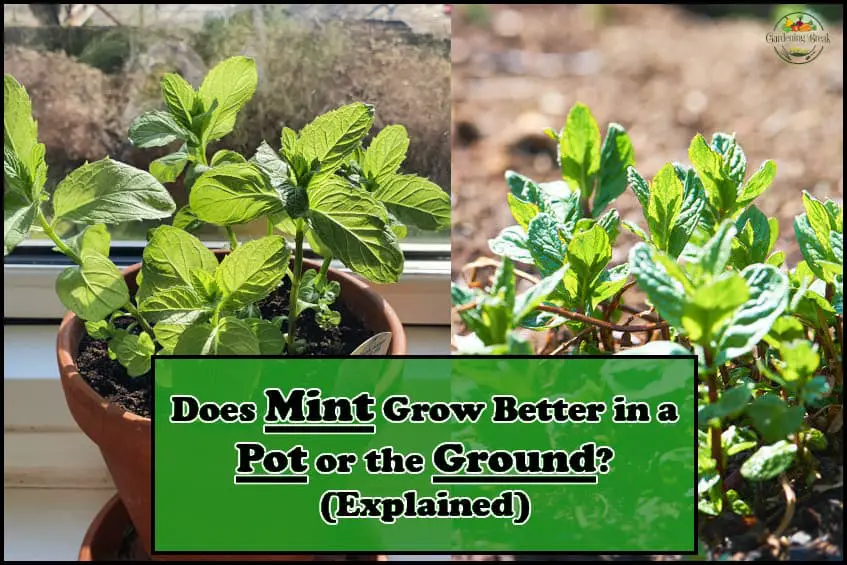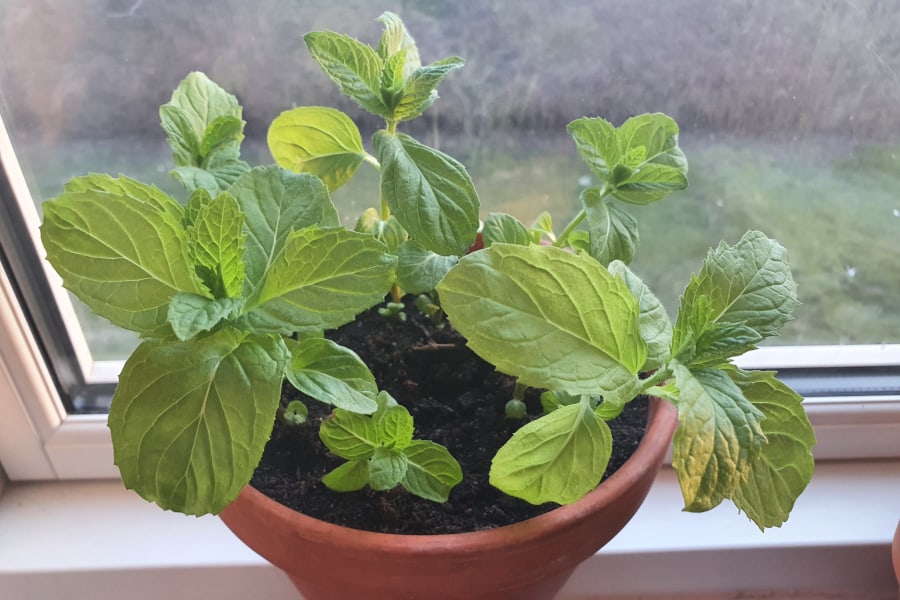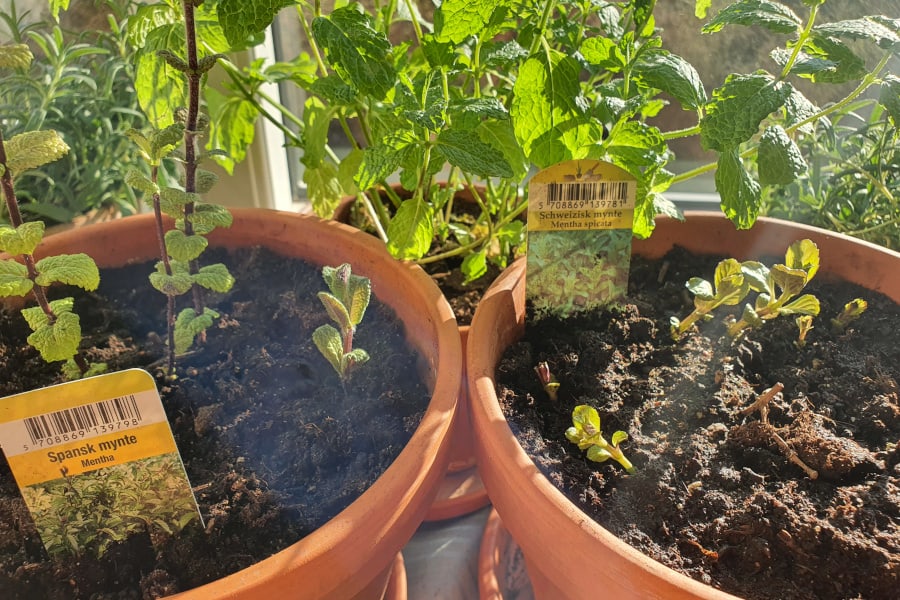Mint is a very versatile herb that can grow well both in pots and in the ground, but there are some important differences between the two methods that make one of them a lot better than the other for almost everybody.
Mint plants can get a lot bigger when growing in the ground than in a pot, but it is much easier to grow it in a pot. Mint spreads rapidly and indefinitely by producing horizontal runners, so unless the purpose is to use it as ground cover, it is best to grow mint in a pot.
In this article, I explain the different situations where it is best to grow mint in a pot and in the ground, so you can easily figure out which method you should use. I also have a cool trick that actually allows you to grow mint in the ground without letting it spread, so keep reading to learn that.

Does Mint Grow Better in a Pot or in the Ground?
Mint can grow very well in both pots and the ground, although it technically can grow better in the ground since there is more room for the roots.
Despite that, it is usually not recommended to grow mint in the ground. I agree with that and highly recommend using a pot for your mint. Here is why.
It is much easier to grow mint in a pot than in the ground. Potted mint can easily be moved around throughout the season, to continuously provide it with the best growing conditions and it is easier to prevent potted mint from spreading.
The key to growing mint, no matter if in a pot or the ground, is to give it the right conditions. I would definitely argue that it is much easier to control the growing conditions for a potted mint than a mint that grows in the ground since the plant is isolated to its own space.
You can move potted mint around as you please to increase or decrease the amount of sunlight and rainwater it gets, and you can control precisely what type of soil you use. The only disadvantage to growing mint in a pot I can think of is that there is limited room for the roots in a pot.
For that reason, “bigger is better” is a good rule of thumb when it comes to choosing a pot for mint, but there is a bit more to it, which you can read all about on this link.
Why You Should (Most Likely) Not Grow Mint in the Ground

If mint grows directly in the ground, it will spread and take over a bigger and bigger area. Mint plants spread indefinitely by producing horizontal runners that grow out from the plant at ground level and establish new roots and stems, making the whole plant wider and wider.
If you allow this to happen for too long, it will very quickly get out of hand to the point where it will be almost impossible to get completely rid of it.
A quick anecdote about mint taking over:
One summer, when we were visiting the in-laws, I noticed my father-in-law walking around their garden and pulling what I thought to be random weeds out of the ground. When I asked about it, it turned out to be mint that he had sown a few years ago but then regretted putting it in the ground and was now struggling to get rid of.
My point is, don’t grow mint in the ground unless you’re absolutely sure you want it to spread.
You can probably keep it down by going around and pulling it out of the ground when it appears like my father-in-law was doing, but it is almost impossible to get completely rid of it since you need to remove all of the roots entirely.
Another advantage of growing mint in a pot is that you can keep it indoors, but growing mint indoors is quite different from growing it outside. You can read more about that on this link.
Luckily, there are tricks to grow mint in the ground without letting it spread if that is what you want. I recently learned a cool trick for this from an employee at a plant nursery, which I will share now.
How to Grow Mint in the Ground Without Letting It Spread

The only way to prevent mint plants from spreading in the ground is to physically block them from being able to. I have some tips for doing that as easily as possible.
A couple of weeks before I wrote this article, I visited a nearby plant nursery to buy a few different varieties of mint plants. I asked one of the gardeners there if she had some tips for growing mint in the ground without letting it spread, and she actually shared a really cool trick with me, which I will now share with you.
To keep mint in the ground but prevent it from spreading, dig a hole and put a large, bottomless pot in it in which you plant your mint. Keep a few inches of the pot above ground to block mint runners from spreading easily.
With this method, the walls of the pot physically block the mint runners from spreading, and the bottom of the pot should be deep enough so that only roots and no runners will grow out through it.
I found this method to be super interesting, so I decided to read a little more about it and found a post from The Royal Horticulture Society that explains a similar method for growing mint in the ground. They also suggest using a large pot or even a bottomless bucket sunk into the soil with the rim above ground.
The cool thing about this method is that you don’t have to dig very deep because mint runners typically grow at ground level, so as long as the bottom of your pot or bucket is a few inches under the surface of the ground, they won’t grow through it.
Even though these methods, if done correctly, will almost always prevent mint from spreading, it is still a really good idea to look out for runners once in a while, because it can happen that they grow over the edge of the pot or bucket and finds their way to the soil.
Compared to growing mint directly in the ground, you have a lot more time to identify the runners before they start growing roots in the ground if you use this method.
This method is actually also an excellent way to grow different mint varieties near each other, which is the reason I asked the nursery employee about it in the first place. Usually, different mint varieties would get mixed if grown too close together, which can lead to some issues, but this method can prevent that. You can read much more about growing different mint varieties together on this link.
Chances are that growing mint in a pot is the best method for you, but there is at least one reason why growing it in the ground can be a better choice, so let’s get into that.
Only Grow Mint in the Ground if You Want This to Happen
Mint is super invasive, and once it becomes well-established in the ground, it is almost impossible to get rid of.
Even though this means you should be careful with how and where you grow your mint, it also gives you the option of using the plant as a ground cover, which mint actually works really well as.
According to The Spruce, two mint plants should be enough to cover a few feet of ground because they grow so aggressively. So don’t overestimate how many mint plants you need from the beginning if you want to use it as ground cover, as a few of them usually do the trick.
To create a mint ground cover, plant a few mint plants or cuttings with 2-3 feet between each other and allow time to do its thing while you watch the plants spread.
Depending on how big your garden is and where you plant your mint, you should know that there is a very real possibility that it will eventually spread to your neighbors’ gardens, which might make you a bit unpopular, so keep that in mind before you plant your mint.

